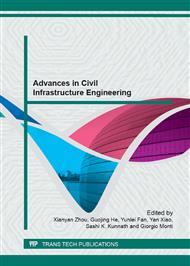p.325
p.329
p.334
p.341
p.346
p.350
p.354
p.359
p.364
Research on the Relationship between Clay Content in Aggregate and Water Stability of Rubber Asphalt Mixture
Abstract:
In order to verify the characterization degree of water stability, research selects some clay content aggregate retrieved from road engineering field to produce rubber asphalt mixture and carry out the water stability test. Test results show that clay content in aggregate has a significant influence on the water stability of rubber asphalt mixture. When the content of clay in aggregate less than 1%, the influence on water stability is smaller; when the clay content exceeds 2%, the decay rate on water stability performance and long term properties obviously speed up, resulted in serious water damage.
Info:
Periodical:
Pages:
346-349
Citation:
Online since:
January 2013
Authors:
Price:
Сopyright:
© 2013 Trans Tech Publications Ltd. All Rights Reserved
Share:
Citation:


